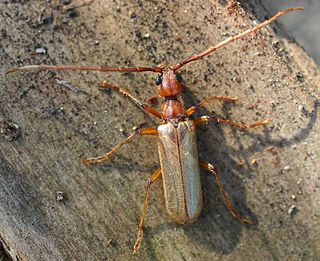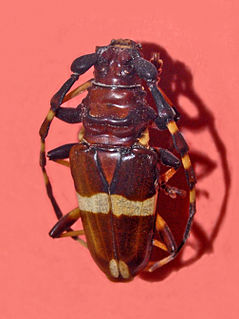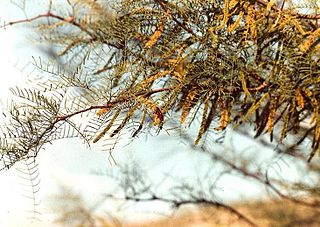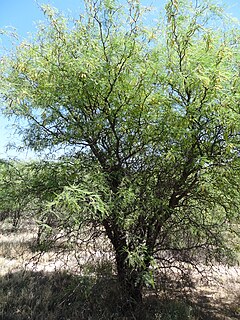
The longhorn beetles (Cerambycidae), also known as long-horned or longicorns, are a large family of beetles, with over 35,000 species described. Most species are characterized by extremely long antennae, which are often as long as or longer than the beetle's body. In various members of the family, however, the antennae are quite short and such species can be difficult to distinguish from related beetle families such as the Chrysomelidae. The scientific name of this beetle family goes back to a figure from Greek mythology: after an argument with nymphs, the shepherd Cerambus was transformed into a large beetle with horns.

Prosopis alba is a South American tree species that grows in central Argentina, the Gran Chaco ecoregion, and part of the Argentine Mesopotamia, as well as Bolivia, Paraguay, and Peru. It is known as algarrobo blanco in Spanish. Spanish settlers gave it that name because of its similarity to the European carob tree. Other common names come from Guaraní, including ibopé and igopé.

Prosopis laevigata, commonly known as smooth mesquite, is a species of flowering tree in the pea family, Fabaceae, that is native to Mexico, Bolivia, Peru, and north-western Argentina. In Mexico, the species is found in the nation's the central highlands, the lowlands of southern Tamaulipas, and in parts of Oaxaca, Morelos, Puebla, and Chiapas. It grows on a variety of sites on hillslides, in depressions, and along floodplains. It has been spotted growing in the Middle East as well.

The Disteniidae are a small family of beetles in the superfamily Chrysomeloidea, traditionally treated as a group within the Cerambycidae.

The Vesperidae are a small family of beetles, normally classified within the family Cerambycidae, of heterogeneous aspect but all characterised by larval stages related to roots of herbaceous plants or trees

Trachyderini is a tribe of long-horned beetles in the family Cerambycidae. There are at least 140 genera and 650 described species in Trachyderini.

Dorcacerus barbatus is a species of beetle in the family Cerambycidae, the only species in the genus Dorcacerus.

Atrypanius conspersus is a species of longhorn beetle of the subfamily Lamiinae. It was described by Ernst Friedrich Germar in 1824 and is known from Mexico to Panama, as well as southern Amer and Bolivia. It also inhabits woodlands of Upper Amazons and capital of Brazil, Rio de Janeiro.

Trachyderes cingualtus is a species of beetles in the family Cerambycidae. This species can reach a length of 25–35 millimetres (0.98–1.38 in). It is present in Brazil, Peru and Bolivia.

Taeniotes scalatus is a species of flat-faced longhorn beetle in the subfamily Lamiinae of the family Cerambycidae.
Chlorida spinosa is a species of beetle in the family Cerambycidae. It was described by Per Olof Christopher Aurivillius in 1887. It is known from Colombia, Bolivia and Peru. Adult males produce (6E,8Z)-6,8-pentadecadienal, an attractant pheromone.
Ranqueles mus is a species of beetle in the family Cerambycidae. It was described by Pierre-Émile Gounelle in 1906. It is known from central and northwestern Argentina. It feeds on Prosopis nigra.

Compsocerus violaceus is a species of beetle in the family Cerambycidae. It occurs in South America, being common in southern Brazil, northern Argentina and Uruguay.
Minibidion unifasciatum is a species of beetle in the family Cerambycidae. It was described by Ubirajara Ribeiro Martins and Maria Helena M. Galileo in 2007. The holotype was deposited in the Noel Kempff Mercado Natural History Museum, Universidad Autónoma Gabriel René Moreno in Santa Cruz de la Sierra, Bolivia.

Prosopis chilensis is a species of tree in the genus Prosopis, belonging to the family Fabaceae. It is found in parts of central Chile, southern Peru, Bolivia, and Andean (northwestern) Argentina. Its common names include Chilean mesquite, cupesí, and Chilean algarrobo. It is used for providing shade, for animal feed and for firewood.

Prosopis flexuosa, commonly known as tortuous mesquite and a variety of Spanish vernacular names including algarrobo dulce and algarrobo negro, is a species of flowering tree in the genus Prosopis of the family Fabaceae. It is found in arid and semi-arid regions of Argentina, Bolivia and Chile, including the western Gran Chaco and the Monte Desert, where it is a conspicuous and characteristic plant of the region. Its timber is used for construction, charcoal and fuel and its fruits are eaten by humans and livestock.
Curuapira apyama is a species of beetle in the family Cerambycidae. It was described by Martins and Galileo in 2005. It is known from Bolivia.
Obereoides antennatus is a species of beetle in the family Cerambycidae. It was described by Martins and Galileo in 2003. It is known from Bolivia.
Cacostola brasiliensis is a species of beetle in the family Cerambycidae. It was described by James Thomson in 1868. It is known from Brazil.
Oncideres saga is a species of beetle in the family Cerambycidae. It was described by Dalman in 1823. It is known from Paraguay, Argentina, Uruguay and Brazil. It feeds on Acacia decurrens, Prosopis alba, Prosopis nigra, and Parapiptadenia rigida.












